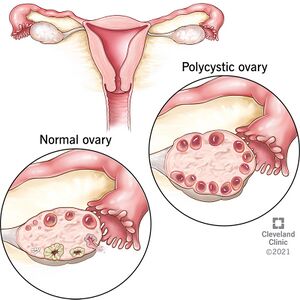The Interrelationship of Polycystic Ovarian Syndrome and the Gut Microbiome
Introduction

Polycystic Ovarian Syndrome (PCOS), alternatively referred to as polycystic ovary syndrome, is a hormonal disorder that occurs when ovaries create and secrete excessive androgen. PCOS has a variety of defining characteristics, including hormonal imbalance, ovarian cysts, infertility, and irregular menstrual cycles.[1] These characteristics may be accompanied by complications such as obesity, insulin resistance, dysbiosis, dyslipidemia, impaired glucose metabolism, miscarriages, cardiovascular disease, sleep apnea, and cancer.1, 2 When left untreated, complications such as these are more likely to arise, causing a significant burden on many afflicted people assigned female at birth (AFAB).
PCOS affects an estimated 8–13% of people AFAB within reproductive age, accounting for 50%~70% of anovulatory infertility.1, 3 However, an estimated 70% of cases are undiagnosed worldwide.3 General symptoms usually arise during early puberty and include acne or oily skin, excessive hair on the face or body, irregular periods, infertility, irregular hair growth/loss, and abdominal weight gain.3 Just as there is no singular symptom for PCOS, there is no singular test to diagnose it; therefore, many different variables are taken into account in order to make a diagnosis. Most commonly, a PCOS diagnosis is made during early reproductive years through a consideration of symptoms, followed by blood tests, pelvic exams, and/or ultrasounds.4
Despite PCOS's widespread occurrence and impact, its precise etiology and pathology are still not fully understood. It is known that there is a significant genetic component to the acquisition of PCOS. It is considered to be a polygenic complex genetic trait, as it is believed that PCOS inheritance occurs from multiple genes.5 However, recent studies have begun to shed light on additional factors that impact the development and interworkings of PCOS. For example, new research has begun to reveal a connection between PCOS and the human gut microbiome.
Section 1 The Role of Pleiotropy
Pleiotropy plays a significant role in the regressive evolution of eyes in cave-dwelling organisms, including mollies and Astyanax cavefish. Pleiotropy refers to a single gene influencing multiple traits, often resulting in evolutionary trade-offs. In cavefish, for example, genes associated with eye development also affect other traits critical for survival in the dark. One prominent gene implicated in this process is the Hedgehog (Hh) gene. Its altered expression not only reduces eye size but also increases taste bud density, which improves the fish's ability to detect food in nutrient-scarce cave environments.
Gene mapping of Mexican Astyanax reveals that three distinct genes across separate chromosomes influence eye development. Notably, one of these genes is closely associated with a gene regulating metabolic rate. This genetic linkage suggests that mutations enhancing metabolism might simultaneously impair eye development, providing evidence that pleiotropy may drive the regressive evolution of cavefish eyes. (reference)
Similarly, changes in jaw morphology and olfactory structures, likely linked to pleiotropic effects, further highlight the adaptive benefits of traits compensating for the loss of vision. For instance, mutations that impair eye development may also enhance the width of the olfactory pit, illustrating how natural selection can indirectly favor the loss of eyes through benefits to other systems.The absence of eyes also causes morphological changes that indirectly benefit cavefish. The bones surrounding the eye socket are repurposed, deforming the skull in ways that enhance other senses such as olfactory perception. Blind cavefish exhibit a 13% increase in the width of the olfactory pit, enlarging the surface area of the olfactory epithelium. This adaptation improves their sense of smell, enabling them to detect chemical cues, food in their environment more effectively. The deformation of the skull due to eye loss results in broader nasal structures, further increasing olfactory efficiency.
Call out each figure by number (Fig. 1).
Sample citations: [2]
[3]
A citation code consists of a hyperlinked reference within "ref" begin and end codes.
For multiple use of the same inline citation or footnote, you can use the named references feature, choosing a name to identify the inline citation, and typing [5]
Second citation of Ref 1: [2]
Here we cite April Murphy's paper on microbiomes of the Kokosing river. [6]
Section 2 Microbiome
Include some current research, with a second image.
Here we cite Murphy's microbiome research again.[6]
Conclusion
You may have a short concluding section.
Overall, cite at least 5 references under References section.
References
- ↑ Sun Y, Gao S, Ye C, Zhao W. Gut microbiota dysbiosis in polycystic ovary syndrome: Mechanisms of progression and clinical applications. Frontiers in Cellular and Infection Microbiology. 2023 Feb 24;13.
- ↑ 2.0 2.1 Zigli DD, Brew L, Obeng-Denteh W, Kwofie S. On the Application of Homeomorphism on Amoeba Proteus. Ghana Journal of Technology. 2021 Mar 31;5(2):43-7.
- ↑ Bartlett et al.: Oncolytic viruses as therapeutic cancer vaccines. Molecular Cancer 2013 12:103.
- ↑ Lee G, Low RI, Amsterdam EA, Demaria AN, Huber PW, Mason DT. Hemodynamic effects of morphine and nalbuphine in acute myocardial infarction. Clinical Pharmacology & Therapeutics. 1981 May;29(5):576-81.
- ↑ 5.0 5.1 text of the citation
- ↑ 6.0 6.1 Murphy A, Barich D, Fennessy MS, Slonczewski JL. An Ohio State Scenic River Shows Elevated Antibiotic Resistance Genes, Including Acinetobacter Tetracycline and Macrolide Resistance, Downstream of Wastewater Treatment Plant Effluent. Microbiology Spectrum. 2021 Sep 1;9(2):e00941-21.
Edited by [Lauren Karg], student of Joan Slonczewski for BIOL 116, 2024, Kenyon College.
